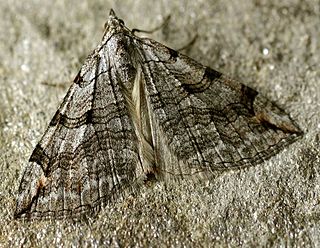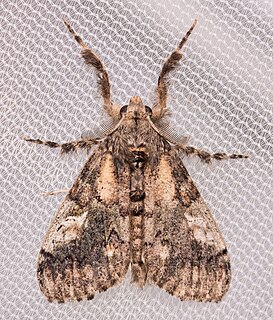
Convolvulaceae, known commonly as the bindweed or morning glory family, is a family of about 60 genera and more than 1,650 species of mostly herbaceous vines, but also trees, shrubs and herbs, and also including the sweet potato and a few other food tubers.

The treble-bar or St. John's wort inchworm is a moth of the family Geometridae. the species was first described by Carl Linnaeus in his 1758 10th edition of Systema Naturae. It is found throughout the Palearctic region and the Near East.

Castulo is a genus of moths in the subfamily Arctiinae erected by Francis Walker in 1854. The genus consists of two species, both found in Australia.

Dasychira plagiata, the northern pine tussock or northern conifer tussock, is a moth of the family Erebidae. The species was first described by Francis Walker in 1865. It is found in North America from Newfoundland and Labrador to Alberta, in Massachusetts, New York and North Carolina.
Asota plagiata, the two-spots tiger moth, is a moth of the family Erebidae first described by Francis Walker in 1854. It is found in the northern half of Australia.
Tetracanthagyna is a genus of dragonflies in the family Aeshnidae.

Praedora plagiata is a moth of the family Sphingidae. It is known from savanna from Zimbabwe to Tanzania.

Temnora plagiata is a moth of the family Sphingidae. It is found in Africa.

Temnora spiritus is a moth of the family Sphingidae. It is known from forests from Sierra Leone to Congo, Uganda and western Kenya.

Tiracola plagiata, the cacao armyworm, is a moth of the family Noctuidae. The species was first described by Francis Walker in 1857. It is found from south-east Asia, South India, Sri Lanka, Myanmar to the South Pacific Islands, including the northern two-thirds of Australia.
Castulo plagiata, the yellow-banded footman, is a moth of the subfamily Arctiinae. The species was first described by Francis Walker in 1854. It is found in the Australian states of New South Wales, Victoria and Tasmania.

The gray hawk or Mexican goshawk is a smallish raptor found in open country and forest edges. It is sometimes placed in the genus Asturina as Asturina plagiata. The species was split by the American Ornithological Society (AOU) from the gray-lined hawk. The gray hawk is found from Costa Rica north into the southwestern United States.
Eunidia plagiata is a species of beetle in the family Cerambycidae. It was described by Charles Joseph Gahan in 1898. It is known from Chad, Kenya, Zimbabwe, Mozambique, Ethiopia, South Africa, Botswana, and Tanzania.
Cremnosterna plagiata is a species of beetle in the family Cerambycidae. It was described by White in 1858. It is known from Myanmar, Malaysia, India, and Thailand.
Pyrota plagiata is a species of blister beetle in the family Meloidae. It is found in Central America and North America.

Sirthenea is a genus of corsairs in the family Reduviidae. There are at least 40 described species in Sirthenea.
Psyllobora plagiata, the plagiate psyllobora, is a species of lady beetle in the family Coccinellidae. It is found in North America.

Canifa is a genus of false flower beetles in the family Scraptiidae. There are at least four described species in Canifa.
Canifa pallipes is a species of false flower beetle in the family Scraptiidae. It is found in North America.
Nocloa plagiata is a species of moth in the family Noctuidae. It is found in North America.









